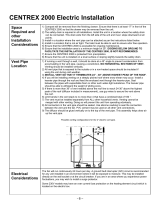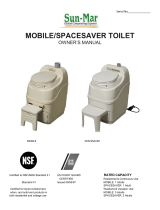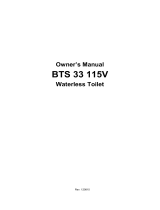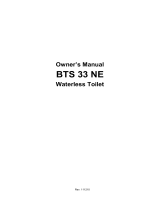Page is loading ...

CENTREX 1000 Electric Installation
- 6 –
Space
Required and
other
Installation
Considerations
Vent Pipe
Location
Electrical
Considerations
1. Compost will be removed from the finishing drawer. Ensure that there is at least 15” in front of the
CENTREX 1000, so that the drawer may be removed from the unit.
2. The safety drain is required in all installations. Install the unit in a location where the safety drain
can be connected. This drain exits from the left side of the unit and must slope downward at all
points.
3. Install in a location where the vent pipe can be attached as per the instructions listed below.
4. Install in a location that is not air tight. The toilet must be able to vent to ensure odor free operation.
5. Ensure that the CENTREX 1000 is accessible for ongoing maintenance.
6. Ensure that the installation area is a minimum height of 28”. DIGGING BELOW GROUND TO
FACILITATE THE INSTALLATION OF THE CENTREX 1000, IS NOT RECOMMENDED.
7. Ensure the CENTREX 1000 is protected from precipitation.
8. Ensure that the unit is installed on a level surface or sloping slightly towards the safety drain.
1. If running a vent through a wall, it should be done at a 45° angle to prevent condensation from
accumulating in the vent pipe, causing a constriction. NO HORIZONTAL SECTIONS OF VENT.
Venting should be installed vertically.
2. All vent pipe that is exposed to the outside or in a non-heated space should be insulated if
using the unit during cold weather.
3. INSTALL VENT SO THAT IT TERMINATES 24” - 30” ABOVE HIGHEST PEAK OF THE ROOF.
4. If you will be installing venting on a steeply pitched roof where snow shear may occur; Install a
heavier pipe through the roof and feed the enclosed vent through the heavier pipe. Seal
between the pipes with expandable foam or other such water-tight substance. The heavier pipe
should be able to withstand the weight of sliding snow.
5. If there is more than 36” of vent needed above the roof line to reach 24-30” above the highest
peak of the roof (diffusor included in measurement), use guy wires to secure the vent above
the roof.
6. Limit bends in the vent stack to no more than 4 that have a combined total of 180 °.
7. The vent must be installed separately from ALL other household vents. Venting cannot be
merged with other venting. Doing so will prevent the unit from operating odorlessly.
8. All connectors in the vent pipe should be sealed. Use silicone caulking to seal the connection
between the vent and the fan. PVC cement may be used on all other vent connections.
9. The diffusor should be glued vertically on to the top of the vent pipe. This assembly helps draw air
up the vent pipe.
Possible venting configurations for the 2” electric vent pipe.
The fan will run continuously 24 hours per day. A ground fault interrupter (GFI) circuit is recommended
for any unit installed in an environment where it will be exposed to moisture. This may be installed
directly on the wall socket or at the circuit breaker. If you are in an area where you experience power
fluctuations, you may wish to install a surge protector.
Some 230V models may have an over current fuse protection on the heating element circuit which is
located on the electric box.

CENTREX 1000 NE (Non-Electric) Installation
- 7 –
Space
Required and
other
Installation
Considerations
Vent Pipe
Location
Vent Inlet
Coupling
1. Compost will be removed from the finishing drawer. Ensure that there is at least 15”
in front of the CENTREX 1000 NE so that the drawer may be removed from the unit.
2. The safety drain is necessary for ALL installations. Install the unit in a location where
the safety drain can be connected. This drain exits from the left side of the unit and
must slope downward at all points.
3. Install in a location where the vent pipe can be attached as per the instructions listed
below.
4. Install in a location that is not air tight. The toilet must be able to vent to ensure odor
free operation.
5. Ensure that the CENTREX 1000 NE is accessible for ongoing maintenance.
6. Ensure that the installation area is a minimum of 28” in height. DIGGING BELOW
GROUND TO FACILITATE THE INSTALLATION OF THE CENTREX 1000 IS NOT
RECOMMENDED.
7. Bends in the vent, installation near hills or over hanging trees may cause down draft.
A 12 volt fan may be necessary.
8. Competing appliances (ie. wood stove) may require an air intake installed from the
outdoors if the unit is installed in an enclosed basement. A 12 volt fan may be
required.
9. Ensure that the unit is installed on a level surface or sloping slightly towards the
safety drain.
1. All vent should be vertically installed.
2. Limit bends in the vent stack to no more than 2 - 45 °
bends. NO HORIZONTAL SECTIONS OF VENT.
3. INSTALL VENT SO THAT IT TERMINATES 24” - 30”
ABOVE HIGHEST PEAK OF THE ROOF. If the vent
is being installed on a steeply pitched roof where snow
shear may occur; Install a heavier pipe through the
roof and feed the enclosed vent through the heavier
pipe. Seal between the pipes with expanding foam or
other such water-tight material. The heavier pipe
should be able to withstand the weight of sliding snow.
4. If there is more than 36” of vent needed above the roof
line to reach 24-30” above the highest peak of the roof
(diffusor included in measurement), use guy wires to
secure the vent above the roof.
5. The vent must be installed separately from ALL other
household vents. Venting cannot be merged with
other venting. Doing so will prevent the unit from
operating in an odorless fashion.
6. All connectors in the vent pipe should be sealed. Use
silicone caulking to seal the connections.
7. The diffusor should be glued vertically on to the top of
the vent pipe. This assembly helps draw air up the
vent pipe.
Place the vent inlet coupling into the hole on the top of
the unit for the 4” vent and so that the 1” of smaller
diameter pipe is protruding into the hole. This is the first
piece of the venting. Once you have finished assembling
the vent, run a bead of silicone around where the inlet
coupling meets the top of the composting unit to prevent
odor from escaping.

Installation Common To Electric Or NE Units
-
- 8 -
Leading the
vent through the
roof
Leading the
vent through the
wall
The Diffusor
Drain
Installation
Handling
Effluent
The vent stack (shown in diagram) should end
approximately 30” above the peak of the roof so that
it is less subject to downdraft. Where the pipe is
taken through the roof, a roof flashing may be
required to seal the installation. If you are in an area
where snow shear is a danger, you may wish to
install a heavier pipe around the vent pipe where it
exits from the roof. If you do choose to do this,
ensure that you seal the area between the pipes
with a waterproof substance to prevent leaks.
When it is necessary to lead the vent through a wall,
connect one 45° elbow on the vent outlet on the unit.
Using a hole saw or other appropriate tool, cut a
hole through the wall board behind the unit so that
the vent pipe can be inserted into the 45° elbow. Cut
a similar hole on the other side of the wall that is
slightly higher than the inner hole so that the vent
pipe will be angled upward at 45°. If installing
through an exterior wall, waterproof sealant will be
required around the vent pipe where it emerges from
the building.
The diffusor provided with the unit is a simple device
to be installed at the top of the vent stack with the
larger pipe protruding above the smaller. To install,
simply glue the diffusor vertically on the topmost
section of vent pipe. The diffusor design encourages
updraft, and discourages wind and weather from
going down the vent stack. We do not recommend
installing anything else on the top of the vent as it
could impede the venting. Unlike wind
turbines,
diffusors are less likely to freeze in winter, and are
more effective in calm weather.
The safety drain must be connected as it will be required in all Centrex 1000 NE
installations or Centrex 1000 electric with ultra-low flush toilets.
- Remove the orange cap from one side of the overflow drain assembly.
- Place a 1” hose clamp over the end of the drain hose that will be connected to the
overflow drain assembly.
- Push the drain hose over the ribbed end of the over-flow drain and clamp with the 1”
SS hose clamp.
- Connect the 1” hose to an approved drainage facility.
- The safety drain is gravity fed. The drain hose must be below the level of the safety
drain in order to function.
The following are possible options to take care of the liquid :
- Feed into a lined pit filled with gravel and sand. Such a
recycling bed also ensures a closed loop system.
- Feed into a small cesspit or “French drain”.
- Plumb into an existing septic or holding tank line.
Installation should be in accordance with applicable local
regulations.

– 9 –
Installing the
waste pipe
Installing the
Ultra Low
Flush Toilet
When installing the waste pipe from the toilet to the unit, the following
should be considered:-
1. The pipe should be either 45 ° or vertical (if composting unit is directly
below toilet), or at a 2-3 ° angle (1/8”-1/4” or 3-13mm drop per foot
maximum) so that the waste travels with the liquid.
2. Pipe should not slope upwards at any point.
3. Connections should be snug so that waste does not cause blockage.
4. It is recommended that the waste pipe be no longer than 15 feet (460cm)
without installing a clear out port(a Y fitting with screw on end cap) near
the toilet to provide easy access should it be required.
5. Use a soft sealant, such as silicone for the connection of the waste
pipe to the unit so that the unit can be moved for servicing or other
reasons should this ever be required.
6. Insulate pipe if unit is to be used during the winter.
7. For longer installations of waste pipe, ensure the waste pipe is supported
to prevent sagging.
1. Make sure the center of the floor flange is at
least 11 inches (280mm) from the back wall.
2. When Installing a new floor flange, ensure
that the toilet mounting bolts align properly
with ultra low flush toilet mounting pattern.
3. Secure flange to floor using flat head screws
through counter-sunk holes in flange. Insert
bolts into slotted holes in flange(Fig. A)
4. Position floor seal by pressing the floor bolts
up through the holes in the seal.
5. Set toilet in place with bolts protruding up
through mounting holes in base (Fig C).
6. Install washers and hex nuts provided with
toilet. Tighten
nuts down equally with
standard 7/16” (12mm) open end wrench.
7. Connect water supply line to water valve (1/2”
or 13mm MPT) inlet using appropriate fittings
(Fig D)
8. Turn on water supply and flush toilet to test
for leaks.
9. Attach pedestal and pedal covers to toilet
base. See instructions
below.
/











